This article deals with John’s integration into the Nazarite tradition.
John’s childhood would have been somewhat different from an ordinary child. He was raised in the Nazarite tradition. He would have been taught to read at a very early age, perhaps three or four, and his formal training may have begun as early as fourteen. John is among the few souls consecrated as Nazarite before or at birth (Lk. 1.61-73). The other biblical notables are Samson and Samuel. The Nazarite tradition specifies certain restrictions and services.
Num. 6.1: “And the Lord spake unto Moses, saying, (2) Speak unto the children of Israel, and say unto them, When either a man or woman shall separate themselves to vow a vow of a Nazarite, to separate themselves unto the Lord; (3) He [or she] shall separate himself from wine and strong drink…” and continues with various prohibitions that lead the individual into, “because the consecration of God is upon his head,” from v. 7.
John is often depicted with a halo (earthly angel and/or heavenly man) and as one anointed. Below, his birth (angels present), ministry at Jordan (center), and death illustrate John’s preeminence. Only Samual, who as a high priest appointed Saul and then David, would compare. John the Baptist presented Jesus as the Anointed of God.
Russian Orthodox carving
NAZARITE TRADITION
Nazarite prohibitions are not to be taken in the negative but accepted as an attempt at self-improvement. For instance, by not eating or imbibing anything of the grape, Temptation is bridled. Abstention is intended to place the person on a spiritual platform to proceed. Further, part of the reasoning behind Nazarite prohibitions allows the person to be ‘set aside’ yet still participate in society. It would be of no real value if the Nazarite vision and knowledge were not shared within society. Consecrated to study and seek God makes for a powerful combination. The enlightenment into His spirit, in part expressed through service; these qualities provide a practical dedication that will keynote Walking in the Way.
Nazarites were not specifically ascetic. They may go about their daily work but are also allowed a certain license to travel, visit synagogues, and even remove themselves from the retreat environment, such as Qumran. A person may undertake the Nazarite tradition for a few years or months. Their final act before reentering everyday life was to cut off their hair as a burnt offering. At that time, a person might make other offerings. It is important to note that men or women may partake in the Nazarite tradition.
 Num. 6.5 gives us a valid reason for the Nazarite tradition, “…until the days be fulfilled, in which he separateth himself unto the Lord, he shall be holy.” The spiritual emphasis here is that any man or woman may engage in the journey of holiness. This process allows for spiritual discovery and would strengthen the core of the Jewish people. Another way to explain this would be: though led by God and the speaking of the prophets, who are the prophets speaking to? Are the people merely consigned to being the most common of the most common person? Indeed, God has a direct provision for the edification of His people. This provision is delivered in part within the Nazarite tradition.
Num. 6.5 gives us a valid reason for the Nazarite tradition, “…until the days be fulfilled, in which he separateth himself unto the Lord, he shall be holy.” The spiritual emphasis here is that any man or woman may engage in the journey of holiness. This process allows for spiritual discovery and would strengthen the core of the Jewish people. Another way to explain this would be: though led by God and the speaking of the prophets, who are the prophets speaking to? Are the people merely consigned to being the most common of the most common person? Indeed, God has a direct provision for the edification of His people. This provision is delivered in part within the Nazarite tradition.
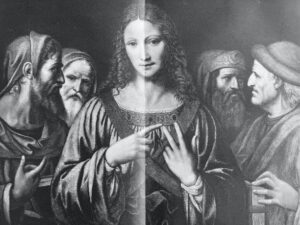
For women today, who often feel left out of biblical tradition, participation in Nazarite tradition by women was allowed. Within Jewish tradition, women were given religious instruction by their husbands. Therefore, Nazarite participation for women allows for a very different spiritual experience. Women do not see things as men do. Women also have the right to edification. Further, women tend to weave the elements of society together and, by nature, receive a different revelation than might a man. In Jesus’ times, women were rarely active in ministry, but he would change that by not only traveling with women but also including them as disciples.
♦
Samson
The connection of Nazarite John the Baptist to Nazarite Samson is somewhat congruent, at least in their early years. As to Samson, Judges 13.1, the wife of Manoah is sterile and childless. An angel of the Lord appears and tells her she will bear a son. She was to remain clean in the Jewish tradition, which also meant no fermented drinks; and ends in v. 5 with:
“Because you will conceive and give birth to a son. No razor may be used on his head because the boy is to be a Nazarite, set apart to God from birth, he will begin the deliverance of Israel from the hands of the Philistines.” This visitation is much like what appeared to John’s father, Zacharias (Lk. 1.5-7; Lk. 1.67-80).
 Scholars interpret Samson’s life as a life of disobedience within the power of God. This viewpoint is usually argued as a settled interpretation due to Samson’s attraction to Philistine women. The minority view perceives Samson’s preference for openly sexual Philistine women as God-driven, for it would allow Samson to confront the Philistines in a manner that could not otherwise occur. For the Philistines, Samson becomes the veritable thorn that no one can remove.
Scholars interpret Samson’s life as a life of disobedience within the power of God. This viewpoint is usually argued as a settled interpretation due to Samson’s attraction to Philistine women. The minority view perceives Samson’s preference for openly sexual Philistine women as God-driven, for it would allow Samson to confront the Philistines in a manner that could not otherwise occur. For the Philistines, Samson becomes the veritable thorn that no one can remove.
Note the lion’s head in the foreground.
Samson is designated to set Israel free from the foreign power of the Philistines. In contrast to Samson, John’s message is not outward-pictured toward the Philistines or the Romans but inward-looking. John’s message points toward the corrupted religious hierarchy of his day, not the corrupted Philisitnes; he points toward the inner person and questions the standard of righteousness to which each person adheres. John stands to the question of the coming Messiah. John’s message would, therefore, seem unusual, if not striking, in that no foreign powers are involved but only the man himself.
For both Samson and John and also included within the Nazarite tradition, the reference to grapes is significant. Grapes, specifically the vineyard, represent stability and permanency in Jewish culture. We may observe a small family vineyard as quaint, but in that day, it was most definitely a step above. Vineyards also require consistent tending. So, not eating grapes symbolically removes the Nazarite from the more significant part of settled life and places his portion in the new consecrated life.
In particular, for the male Nazarite, this freedom from the vineyard lends itself to travel, for a vineyard requires year-round attention. Thus, as an extension of the religious community, the Nazarites can assist in other villages and, as motivated, do good works. This broader involvement in the community might give us a better-defined way of looking at the Nazarite, as opposed to asceticism. Even so, Samson was known to break his Nazarite vows and paid a heavy price for his indulgence.
Nazarites were not hermits. The separation unto God was usually for a proscribed time and alluded more to extra prayer and seeking than it meant separation from the village, as a hermit might do. John probably lived all of his youth in the Nazarite tradition, and if this is accurate, he would have entered the priesthood at age fourteen and could have begun an open ministry at age thirty. Samson would have a similar upbringing to John, however, as a counterpoint, Samson’s duties would be far less the prophet, but much more the avenging judge.
♦
NAZARITE JOHN
Lk. 1: 80, “And the child grew, and waxed strong in the spirit, and was in the deserts till the day of his showing unto Israel.” Mt. 3.1, “In those days came John the Baptist, preaching in the wilderness [desert] of Judea.”
The phrase “in the deserts” refers to desert areas. Villages near the Dead Sea are known to have large Essene populations.
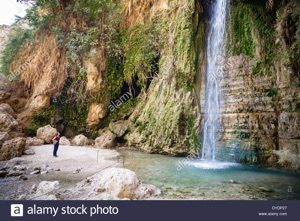 En-Gedi is well watered. Once leaving
En-Gedi is well watered. Once leaving
this area, the desert turns severe.
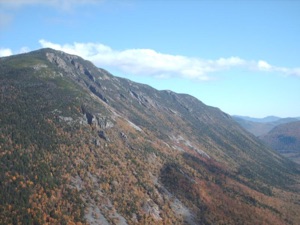 One View of Tekoa Wilderness
One View of Tekoa Wilderness
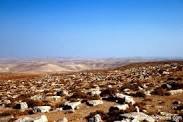 Less verdant area of Tekoa
Less verdant area of Tekoa
Areas like the Tekoa Wilderness might be sought out for a retreat mission. Matt. 3.4, “his meat was locusts and wild honey.” His diet may have been sparse during periods of retreat, but otherwise, his diet would have been traditional. He would have lived among the people and assisted as might be needed.
To John’s movements, who is he preaching to in these wilderness areas? Is he traveling from village to village, assisting and speaking to Essenes located there? Undoubtedly, he would have. Below the age of thirty, John would not yet be old enough to read or comment in the Essene synagogues. However, as a Nazarite, John continued to his destination and purpose. His proving out as a preparer counterposes the vision of a wandering ascetic. In short, walking a mile or two into this desert wilderness provides plenty of isolation and no pressing need to spend weeks or months in this vacuous land. Along with these brief clues, the author, Matthew, assumes anyone else would know who and what exists in the wilderness of Judea. Many small villages would accommodate John’s travels.
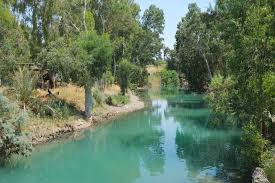 The wilderness stretches to each side of the Jordan, particularly eastward; the Jordan stretches up to the fertile southern tip of the Sea of Galilee. There were many travelers along the Jordan. John may have traveled to Egypt to visit and learn from Jews in Alexandria, something almost no one mentions. As he traveled northward along the banks of the Jordan, he would enter the Galilee and the Hauron, lands of the northern Essene, the Nazarenes, and the land of his cousin Jesus.
The wilderness stretches to each side of the Jordan, particularly eastward; the Jordan stretches up to the fertile southern tip of the Sea of Galilee. There were many travelers along the Jordan. John may have traveled to Egypt to visit and learn from Jews in Alexandria, something almost no one mentions. As he traveled northward along the banks of the Jordan, he would enter the Galilee and the Hauron, lands of the northern Essene, the Nazarenes, and the land of his cousin Jesus.
In Mt. 3.5-6, we have, “Then went out to him Jerusalem, and all Judea, and all the regions round about Jordan, and were baptized of him in Jordan, confessing their sins.” So, from the above scripture, it seems John is well enough known when he begins his formal ministry. Many people already knew John or had heard of him and came to hear his pronouncements.
The excitement of John’s ministry grew, and it seems people felt part of something new. The hunger of the people is undeniable. The Pharisees are aware of this growing ministry, and the counsel of the Great Sanhedrin is also aware. Where do all these people come from that they should listen to the ‘wild man of the desert’? Where does John sit with the people that so many would want to hear his words?
Many Christians have the image of John roaming around the desert for some odd number of years with nothing but camel skin and a pair of sandals. It is incredible that they even gave him credit for having sandals. The Essene supplied support groups throughout Judea and to the north into Israel. This fact is well known. Fellowship is necessary while alternating periods of retreat. Gaining wisdom from older teachers is critical. Remember that the Essene felt the compunction about spreading their message as well. John would do that, so undoubtedly, they would have wanted to help him. For this reason, Essene communes south into Judea would be familiar with John.
Elijah slays the priests of Baal.
John’s prophetic dress reflecting Elijah is an essential sign for the people. “…and John had his raiment of camel’s hair, and a leather girdle about his loins,” and Elijah did wear a garment of skin or camel hair with a leather girdle. So, his representation is not rejected, as his appearance is a clear and exalted reference to Elijah. In the times of Jezebel and Ahab (874-853 BC), Elijah turned Israel (northern kingdom) from Baal and Asherah worship. John seems to be about the same business, but John perceives the threat as internal. John’s representation of the Reformer Elijah would pose a threatening sign to those in Jerusalem.
A much more likely scenario of John’s ‘ascetic’ life appears in the course of events. First, he would take some or perhaps most of his priesthood training at the Essene retreat at Qumran or En-Gedi. We accept this now due to John’s overall message—against the Sadducees and Pharisees, combined with a strong repentance message. John lived within a structured religious environment, one that would require him to assist others, remain studious as to the law and the prophets, and, due to being an Ossaean, he would remain celibate.
As to other travels, roadways skirt the length of the Jordan, and these roads naturally become trading thoroughfares. Orthodox Jews would also use these roads to avoid entering Samaria. This roundabout travel would require an extra day, either north or south. Thus, Jericho would play a prominent role as either the journey’s beginning or end. Jericho is a busy trade city blessed by artesian springs, and it has become a fertile ground for preaching. Later, Jericho would be one focal point of John’s ministry.
As John walked throughout Judea, many Jews would have met John and assuredly had spiritual or religious conversations with him. As a Nazarite, John’s reputation would be of great interest and taken seriously. His words would have weight, and his later acceptance as a prophet by the people is not surprising. Scripture indicates isolated times of prayer, Lk. 1.80, “lived in the desert until he appeared publicly to Israel.” But this brief scripture has a double meaning. It tells us he had also removed himself from the ‘Jerusalem crowd’ of Sadducees and Pharisees. John is altogether something other, a kind of prophet not seen before.
The mystic tradition weaves throughout the root of Judaism. Abram would unlikely have left Haran without the urgency of the mystic calling from God. Nor does revelation emerge out of mundane religiosity. The dulled religions of idol worship leave no room for Revelation God, nor the calling into the spiritual promised land—the enlightenment into the spirit of God. John’s time of priesthood training and his times of isolation promoted the mystic nature of Judaism and the mystical presence of God to run full force through him. John’s mystic vision is undeniable and witnessed as he finally brings forward his ministry. Convicted and sure, John’s background indicates a sound religious and spiritual study. With the accolades of the people and his participation with and baptism of them, John completes his prophetic calling.
Matt. 3.5: “People went out to him from Jerusalem and all Judea and the whole region of the Jordan. (6) Confessing their sins, they were baptized by him in the Jordan river,” also, John 3.23, “Now John was baptizing at Aenon near Salim*, because there was plenty of water, and people were constantly coming to be baptized.” As the Jordan is a regular route of travel, this would assist the Essene message and allow him to preach to Essene believers or those who might convert.
*Salim is a natural crossing or fording area for the Jordan. Jesus most likely met John at this location.
In closing, the idea of John stumbling out of the desert shouting “repent,” followed by Jesus cutting a similar figure, is untrue. Support groups are critical in harsh environments, and even with such support, the mission statements for both John and Jesus load the extra burden. It seems Jesus knew more than a few people, Lazarus being the most notable. And, we must ask again, where did all of these people following John suddenly come from? Essene communities were not far away, and the word spread with the crowds coming from Jerusalem and other locations.
John’s assumption of the spirit of God would occur under the tutelage of the priests of his day. This development requires an intellectual and spiritual community—John would have known many people. All of this contributes to fulfilling John’s ministry life. Even though ‘set aside,’ John lived the life and times of his people.

God Bless!


You could certainly see your skills within the work you write. The world hopes for more passionate writers like you who are not afraid to say how they believe. At all times go after your heart.
The Way is essentially a heart-teaching, but with knowledge and wisdom for balance and insight, perception. The Way is not soft nor ‘lovey-dovey’, however, it is rooted in forgiveness-love, for these attributes touch all aspects of human interaction. When you sow to the heart, you are owing to the spirit, the kingdom within. Are you one who sows?
C. Ray
Hi my loved one! I wish to say that this post is amazing, nice written and come with approximately all significant infos. I would like to look extra posts like this .
This story leads me to believe that the Most High God Elohim would prefer all people and nations to become Nazarites! Selah.and Shalom!